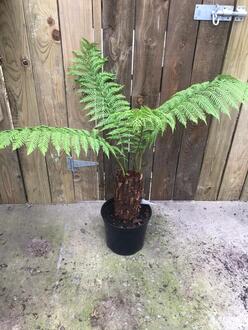|
With their feathered fronds, ferns tree are one of the most elegant prehistoric plants. Here we are going to present the extraordinary, evergreen plants with tips to grow and sow the fern tree. The Antarctic tree fern (Dicksonia Antarctica) is native to the mountain forests of eastern Australia, Tasmania and some sub-Antarctic islands. It is one of the slow-growing tree ferns, but can reach a trunk diameter of 40 centimeters and up to six meters high. As already mentioned, the Antarctic tree fern has the greatest frost tolerance of all tree fern species cultivated here in Central Europe. Dicksonia, both golden fern tree and felted pocket fern, can be recognized by its compact shape and dense-looking fronds. It is also one of the slow growing ferns. The New Zealand pocket fern (Dicksonia Squarrosa) develops a slender, tall trunk that is almost black. It forms a strong contrast to the green of the fern leaves, which are between one and two meters long. Grow:Like all ferns, tree ferns can also be propagated by spores that form in spore containers on the underside of the fronds. In order to collect the mature spores, the fronds are cut off. If the fronds are packed in bags, the ripe spores usually fall off by themselves as soon as the fronds dry a little. You can then sow the spores thinly in the sowing soil - for example germ-free white peat - and press them lightly, but not cover them. Place the seed trays in a shady, warm place and always keep them moist. After about four to six weeks, pre-germs form, which over time give rise to young ferns. When the first fronds show up, the little plants can be pricked out. We usually keep tree ferns as potted plants. Bark humus is recommended as a substrate, to which you add coarse-grained components such as lava gravel, expanded clay or gravel for ventilation. From spring to the first light frosts, the plants can remain outdoors, if possible in a partially shaded to shady location protected from the wind. In principle, the following applies: The shadier and cooler the location, the easier it is to achieve constant humidity. Tree ferns are used to high levels of rainfall in their homeland. You should therefore never dry out, whether outdoors or in the winter garden. Not only do you keep the soil moist, the leaves and, above all, the trunk must be regularly showered with water, for example with a garden hose or watering can. This allows the fibrous tissue that surrounds the trunk to soak up water and provide the entire plant with moisture. In summer you should water and spray the tree ferns every two to three days, in winter once a week. From April to September, tree ferns are fertilized with liquid fertilizer every 14 days. Dried up fern fronds can be cut off without hesitation - they will sprout again in the next spring. Mrs. Joly’s Advice:
0 Comments
Leave a Reply. |
AuthorMeet Mrs. Joly our in House Gardening Expert. Archives
October 2020
Categories |
Follow Us on Instagram @jolysgardencentre |
Phone |
|
COPYRIGHT © 2022 Jolys Garden Center










 RSS Feed
RSS Feed

